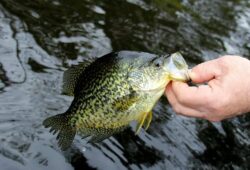One of the main reasons why we catch fish is to take them home for a delicious meal! And if there are one common fish many anglers aim to catch, it’s the crappie. But what does crappie taste like and is it safe to consume it?
You can cook it to perfection and as long as it’s cooked well, you can eat it! Read on as I describe what crappie tastes like and extra tips on cooking this popular fish.
Contents
What Does Crappie Taste Like?
Crappie is a very popular fish in the Southern states, best known for their taste. They are widely found in the United States, which is why many anglers aim to catch these, whether they are novice anglers practicing or for their food that night!
White and crappie fish are completely safe to eat and known as the most delicious panfish to consume. They are high in fat and protein, offering proper nutritional value. So it’s so easy to cook that fish on an offset wood smoker, on an outdoor grill, or even on your kitchen pan.
The crappie has sweet white meat, which feels soft as you chew. However, some people don’t appreciate its taste, as it’s a bit blander compared to other fish like the bluegill.
With that said, crappie is still delicious if well-seasoned. It’s a common food fish because of its bigger size compared to the bluegill, as you can easily fillet larger-sized crappie.
But, they are still a tad smaller compared to other panfish, typically weighing 1-2 pounds. This isn’t a huge problem and can still feed a small group or family well.
Crappie will taste good and is safe to eat as long as you clean, prepare, and cook it properly. I’ll be tackling some quick tips to make crappie have more flavor in the next section!
Read More: Why Does Tilapia Taste Like Dirt? Surprising Facts You Need to Know!
Quick Crappie Cooking Tips

Now that you know that crappie is safe to eat and delicious if cooked well, how can you prepare it? Here are quick tips to ensure that your crappie dish will be a good one!
Prepare the Crappie
Fortunately, crappie is easy to clean and gut when preparing it for cooking. You can do it after catching it even if you aren’t that experienced since you just need a good knife and knowledge of the crappie anatomy.
If you plan to prepare the whole crappie, cut through both sides of the dorsal fin, ripping it out from the root. Next, scale the crappie, creating a diagonal cut so you can remove its head, innards, and ribs in just one motion. You can leave the tail so it will have a crunchy and yummy texture.
I highly recommend that you cook crappie fresh, as the fresher, the better! This will give it a pleasant and flaky texture instead of a mushy one due to cooking frozen fish.
Fillet the Crappie
When filleting the crappie, cut it vertically from behind its gills and angle it towards its head. Continue cutting until the knife hits the backbone, but do NOT cut through its back backbone. Turn the knife horizontally with the blade facing the tail, then run your blade across the whole backbone until the tail.
Pull the meat away from its body, then create one final cut to remove it. The fillet will then be easy to lift away from the body, and you can repeat the steps for the other side. You will now have two crappie fillets to cook.
I like cooking breaded crappie fillets, which are the most popular and easiest recipes to follow. You can also cook it as patties, fresh fish cocktail, or a chowder!
If you want to learn more about how to cook crappie better, check out this informative video:
Wrapping It Up
Crappie is a safe fish to eat, and something many anglers love to cook! They taste amazing as long as they are prepared correctly, so make sure to take care of your catch and keep it fresh until it’s time for you to go home for cooking. That way, you and your family can enjoy your catch!
I hope that this article answers your question, “what does crappie taste like?” So if you caught yourself some crappie, follow these cooking tips, and have a great dinner everyone will appreciate it!




